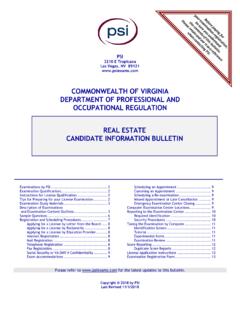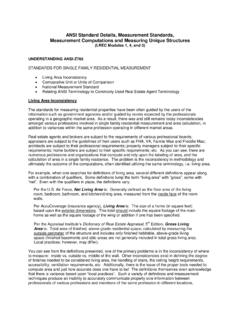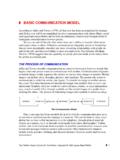Transcription of Lesson 7 Mortgage Loan Origination, Processing, and ...
1 Real Estate Finance Lesson 7 Mortgage loan origination , processing , and servicing Part 1 45 Hour Louisiana Post-Licensing 10/14 Real Estate Finance Lesson 7: Mortgage loan origination , processing , and servicing Page 2 loan origination AND processing loan underwriting, or qualification, is a crucial step in the real estate lending process for both the lender and the borrower. loan qualification is a component of the overall loan application process , and includes not only consideration of the value of the collateral pledged as security, as well as the creditworthiness of the borrower(s). loan application is a chance for the prospective borrower to convince the lender that loan proceeds will be put to good use, and that they will be paid back as agreed. The lender, on the other side of this process , uses the loan application and review procedures to gather relevant information regarding the property and the borrower to evaluate the potential risks associated with making the loan .
2 The applicant s credit scores will be retrieved from the three major reporting agencies and evaluated within the framework of the loan for which the borrower is applying. Scores below certain levels may disqualify an applicant entirely, or place them at a risk profile level requiring more detailed review, supplemental or supporting information, and possibly requiring a higher interest rate on the loan itself. The loan scoring and evaluation must be objective and impartial following all of the regulatory guidelines set forth in laws such as Truth in Lending, Fair Housing and Equal Credit Opportunity. Each of these has one or more forms providing one of many disclosures required, which must be provided to the borrower at specified points in the application process . Failure by the lender to make appropriate disclosures, and/or provide the appropriate documents can, and often does, result in a regulatory compliance violation subject to criticism by examiners.
3 loan application and processing includes a two way flow of information between the borrower and lender, some of which are bureaus, land surveyors, building inspectors and real estate brokers or salespersons. In evaluating the borrower, the lender is attempting to assess the four C s of credit analysis: credit history, character of the borrower, capacity to repay, and collateral value of the asset pledged. Much of the information required for this evaluation is drawn from information provided by the borrower in the loan application, which includes an income statement, balance sheet and employment history. Additionally, the loan officer gathers information through verification of bank and other financial accounts and employment history. The lender requests recent credit reports and may verify through other references the information provided on the application.
4 This information is used primarily to judge the credit history and character of the prospective borrower, as well as to analyze the capacity or ability of the borrower to repay the loan requested when the relationship of monthly debt services payments to income is taken into consideration. The Five Major Elements of Mortgage Lending The five major elements of Mortgage lending includes qualifying the borrower, the property, and the title as well, as closing and then servicing the loan . Each requires a variety of individuals with the appropriate skills and experience necessary to complete a successful transaction. Each of these elements also has its own attendant costs and fees associated with it, which can be a fairly significant amount when taken collectively. This somewhat high transaction cost, when compared to those of say, securities or other investment transactions, is a reflection of the imperfectly competitive nature of real estate markets.
5 Transaction costs can be minimized in some instances, but the complexity of the transaction itself and the need for people with specific types of expertise and experience, make keeping costs low challenging. In fact, some would argue that attempting to get a deal on some closing and financing fees could very well come back to haunt one or more parties to the transaction. The adage you get what you pay for is very applicable, and one that should be considered when one is tempted to take a short cut to lower costs, or retain someone with questionable credentials to provide services. Real Estate Finance Lesson 7: Mortgage loan origination , processing , and servicing Page 3 Qualifying the Property Qualifying the property is essentially a matter of having the collateral appraised and inspected. The appraisal is focused on establishing a Fair Market Value for loan purposes, while the inspections are to verify the collateral s condition and corroborate disclosures made by the current owners/sellers.
6 Since appraisal and inspection are covered elsewhere in this course, the discussion here will be somewhat limited. Suffice it to say that property should be thoroughly inspected by a qualified person(s) who can attest to the condition and physical integrity of the improvements. This would include, but not necessarily be limited to, inspections of the roof, foundation, HVAC systems, plumbing and electrical service, as well as specialty items such as swimming pools, hot tubs/spas, outdoor ancillary buildings ( , RV storage, shops, barns, etc.). Some inspections, such as for pools and spas, may require a specialist with the appropriate experience and equipment to detect hidden defects such as leaks in pool linings, insufficient pump pressures, and the like. The results of independent inspection reports should be compared to the seller disclosure statement to identify, clarify and reconcile discrepancies.
7 The outcome of the inspection may very well dictate whether the next steps of the financing process are embarked upon or terminated if they have already begun. Property inspections are particularly important for older properties, which have been subject to a fair amount of physical wear and tear and functional obsolescence. They are also important in locations that have experienced a significant natural disaster ( , flood, hurricane, tornado, etc.) which inflicted widespread property damage. Inspections in these instances should focus on the quality of the reconstruction, particularly the materials used and measures taken to mitigate future risks associated with mold (from flooding) or structural damage (from sustained hurricane force winds). In the latter instance, the inspection should ascertain as well as possible if updated building codes were followed in the reconstruction process .
8 The Appraisal The appraisal, on the other hand, is primarily concerned with establishing a fair market value for the collateral the lender will be accepting as security for the loan , thus on which they will be placing a lien. Although the appraiser also must conduct an inspection of the property, it is a more cursory unit to verify its size, general condition and conformity with its immediate surroundings, as well as to determine the type of properties that will be chosen as comparables used to establish indications of market value. The appraiser must adhere closely to the Uniform Standards of Professional Appraisal Practice (USPAP,) which were an outgrowth of the FIRREA legislation of the 1980 s and that have, and continue to undergo, revisions and additions. The results of the appraisal are then compiled and reported (as per USPAP) in one of several ways: an oral report, letter report, form report, or full narrative report.
9 Most residential appraisals are reported on either a FNMA/FHLMC form or on either an FHA or VA approved form. The form of the report, while important, does not alter the methodology required for the appraiser to arrive at a supportable and defensible opinion of market value. It is important for everyone involved in the transaction to understand that an appraiser is rendering his or her opinion of value. The opinion is not a fact as such, but is an informed statement by the drawing upon facts extracted from the marketplace, applied within specific methodological steps, reconciled based upon the experience and professional judgment of the appraiser, and rendered as of a specific date. Consequently, the appraisal is subject to review, criticism, alteration, and possibly being completely redone by a different appraiser.
10 Federal regulations have, in effect, created firewalls which separate the appraiser from those who stand to benefit from, or possibly be hurt by the ultimate value opinion rendered. This means that direct communication between the property owner, real estate agent and lender s loan officer and the appraiser selected for a particular assignment is very limited, and in some cases, prohibited. In institutions where the right to select appraisers has been retained, the selection is by random rotation from a list of previously qualified and board approved appraisers. Communication, thereafter, is limited to the bank officer with direct responsibility for managing and overseeing the Real Estate Finance Lesson 7: Mortgage loan origination , processing , and servicing Page 4 appraisal process . This cannot be the loan officer processing the borrower s application.













